MERCEDES-BENZ C-Class 2011 W204 Owner's Manual
Manufacturer: MERCEDES-BENZ, Model Year: 2011, Model line: C-Class, Model: MERCEDES-BENZ C-Class 2011 W204Pages: 320, PDF Size: 13.17 MB
Page 291 of 320
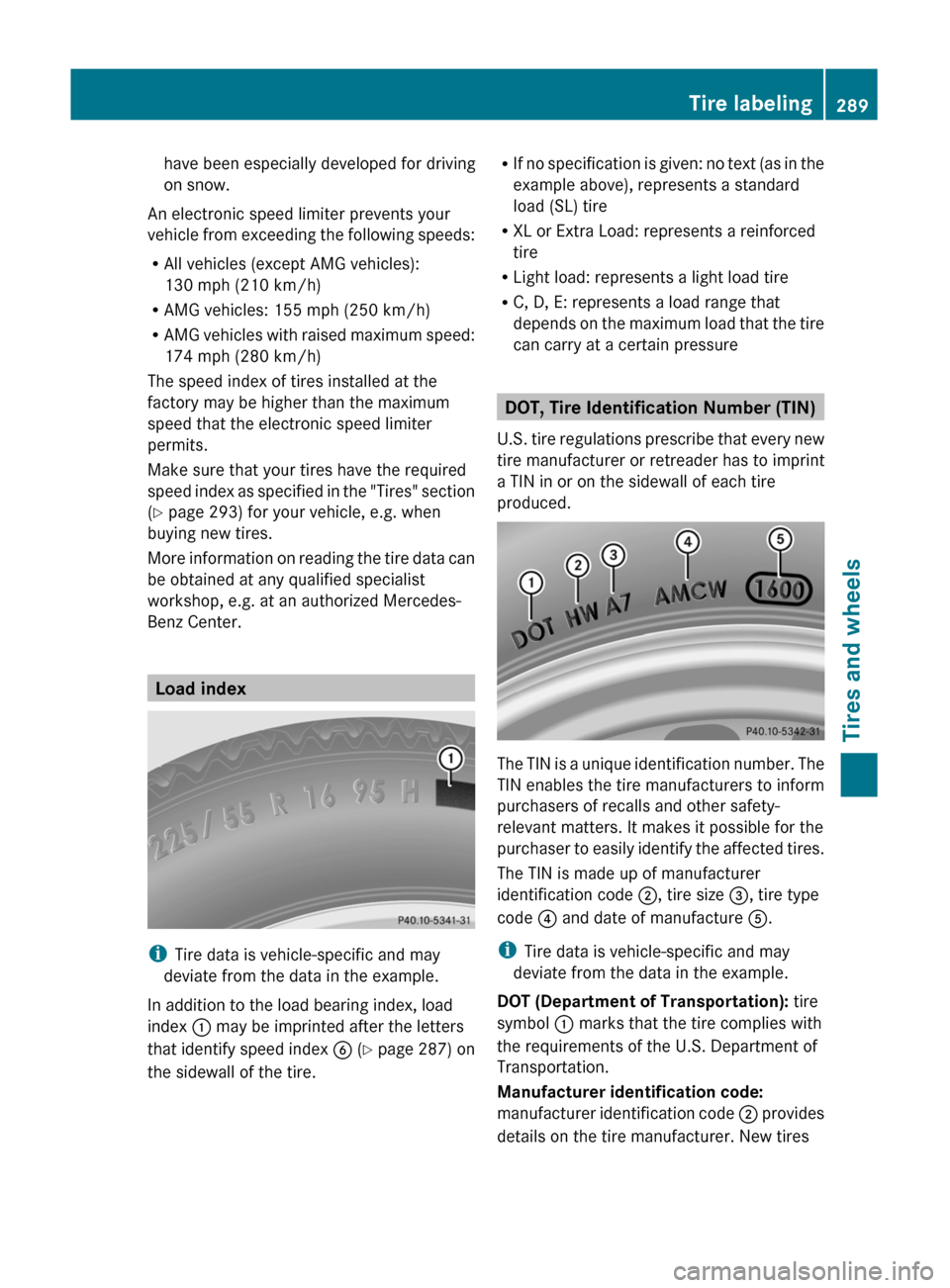
have been especially developed for driving
on snow.
An electronic speed limiter prevents your
vehicle from exceeding the following speeds:
R All vehicles (except AMG vehicles):
130 mph (210 km/h)
R AMG vehicles: 155 mph (250 km/h)
R AMG vehicles with raised maximum speed:
174 mph (280 km/h)
The speed index of tires installed at the
factory may be higher than the maximum
speed that the electronic speed limiter
permits.
Make sure that your tires have the required
speed index as specified in the "Tires" section
( Y page 293) for your vehicle, e.g. when
buying new tires.
More information on reading the tire data can
be obtained at any qualified specialist
workshop, e.g. at an authorized Mercedes-
Benz Center.
Load index
i Tire data is vehicle-specific and may
deviate from the data in the example.
In addition to the load bearing index, load
index : may be imprinted after the letters
that identify speed index B (Y page 287) on
the sidewall of the tire.
R If no specification is given: no text (as in the
example above), represents a standard
load (SL) tire
R XL or Extra Load: represents a reinforced
tire
R Light load: represents a light load tire
R C, D, E: represents a load range that
depends on the maximum load that the tire
can carry at a certain pressure
DOT, Tire Identification Number (TIN)
U.S. tire regulations prescribe that every new
tire manufacturer or retreader has to imprint
a TIN in or on the sidewall of each tire
produced.
The TIN is a unique identification number. The
TIN enables the tire manufacturers to inform
purchasers of recalls and other safety-
relevant matters. It makes it possible for the
purchaser to easily identify the affected tires.
The TIN is made up of manufacturer
identification code ;, tire size =, tire type
code ? and date of manufacture A.
i Tire data is vehicle-specific and may
deviate from the data in the example.
DOT (Department of Transportation): tire
symbol : marks that the tire complies with
the requirements of the U.S. Department of
Transportation.
Manufacturer identification code:
manufacturer identification code ; provides
details on the tire manufacturer. New tires
Tire labeling289Tires and wheelsBA 204 USA, CA Edition A 2011; 1; 5, en-UShereepeVersion: 3.0.3.62010-05-20T09:17:30+02:00 - Seite 289Z
Page 292 of 320
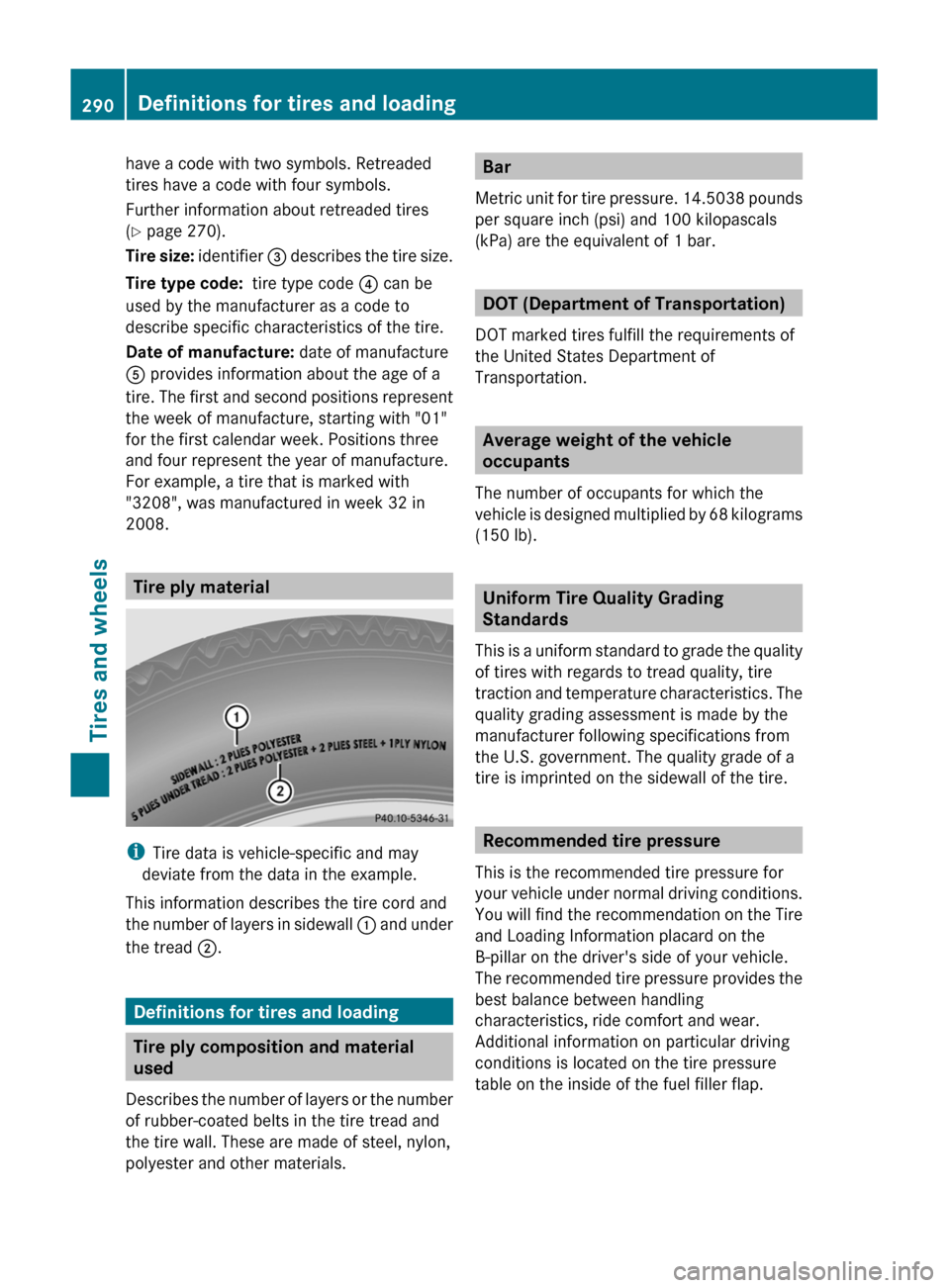
have a code with two symbols. Retreaded
tires have a code with four symbols.
Further information about retreaded tires
( Y page 270).
Tire size: identifier = describes the tire size.
Tire type code: tire type code ? can be
used by the manufacturer as a code to
describe specific characteristics of the tire.
Date of manufacture: date of manufacture
A provides information about the age of a
tire. The first and second positions represent
the week of manufacture, starting with "01"
for the first calendar week. Positions three
and four represent the year of manufacture.
For example, a tire that is marked with
"3208", was manufactured in week 32 in
2008.
Tire ply material
i Tire data is vehicle-specific and may
deviate from the data in the example.
This information describes the tire cord and
the number of layers in sidewall : and under
the tread ;.
Definitions for tires and loading
Tire ply composition and material
used
Describes the number of layers or the number
of rubber-coated belts in the tire tread and
the tire wall. These are made of steel, nylon,
polyester and other materials.
Bar
Metric unit for tire pressure. 14.5038 pounds
per square inch (psi) and 100 kilopascals
(kPa) are the equivalent of 1 bar.
DOT (Department of Transportation)
DOT marked tires fulfill the requirements of
the United States Department of
Transportation.
Average weight of the vehicle
occupants
The number of occupants for which the
vehicle is designed multiplied by 68 kilograms
(150 lb).
Uniform Tire Quality Grading
Standards
This is a uniform standard to grade the quality
of tires with regards to tread quality, tire
traction and temperature characteristics. The
quality grading assessment is made by the
manufacturer following specifications from
the U.S. government. The quality grade of a
tire is imprinted on the sidewall of the tire.
Recommended tire pressure
This is the recommended tire pressure for
your vehicle under normal driving conditions.
You will find the recommendation on the Tire
and Loading Information placard on the
B-pillar on the driver's side of your vehicle.
The recommended tire pressure provides the
best balance between handling
characteristics, ride comfort and wear.
Additional information on particular driving
conditions is located on the tire pressure
table on the inside of the fuel filler flap.
290Definitions for tires and loadingTires and wheels
BA 204 USA, CA Edition A 2011; 1; 5, en-UShereepeVersion: 3.0.3.62010-05-20T09:17:30+02:00 - Seite 290
Page 293 of 320
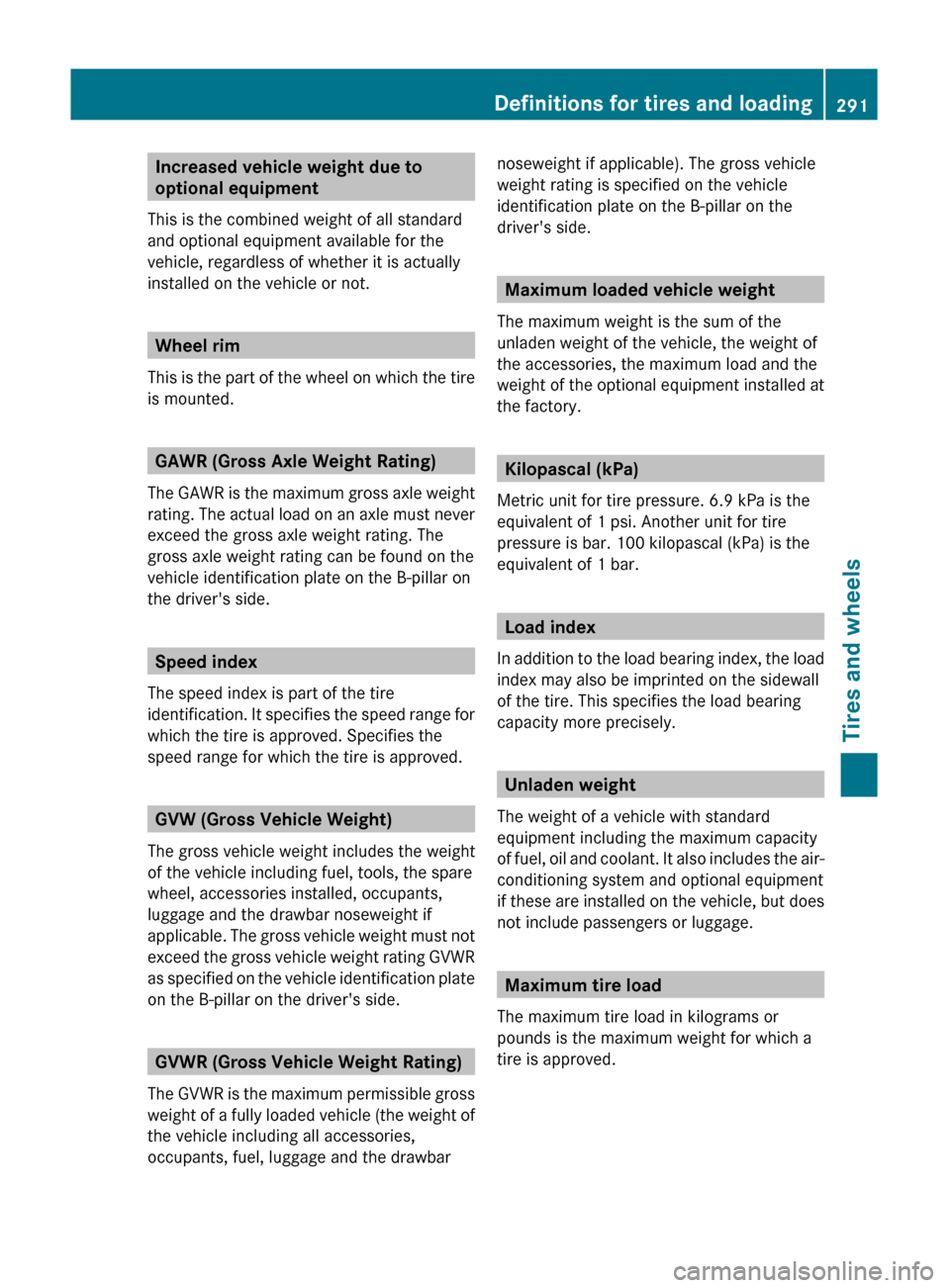
Increased vehicle weight due to
optional equipment
This is the combined weight of all standard
and optional equipment available for the
vehicle, regardless of whether it is actually
installed on the vehicle or not.
Wheel rim
This is the part of the wheel on which the tire
is mounted.
GAWR (Gross Axle Weight Rating)
The GAWR is the maximum gross axle weight
rating. The actual load on an axle must never
exceed the gross axle weight rating. The
gross axle weight rating can be found on the
vehicle identification plate on the B-pillar on
the driver's side.
Speed index
The speed index is part of the tire
identification. It specifies the speed range for
which the tire is approved. Specifies the
speed range for which the tire is approved.
GVW (Gross Vehicle Weight)
The gross vehicle weight includes the weight
of the vehicle including fuel, tools, the spare
wheel, accessories installed, occupants,
luggage and the drawbar noseweight if
applicable. The gross vehicle weight must not
exceed the gross vehicle weight rating GVWR
as specified on the vehicle identification plate
on the B-pillar on the driver's side.
GVWR (Gross Vehicle Weight Rating)
The GVWR is the maximum permissible gross
weight of a fully loaded vehicle (the weight of
the vehicle including all accessories,
occupants, fuel, luggage and the drawbar
noseweight if applicable). The gross vehicle
weight rating is specified on the vehicle
identification plate on the B-pillar on the
driver's side.
Maximum loaded vehicle weight
The maximum weight is the sum of the
unladen weight of the vehicle, the weight of
the accessories, the maximum load and the
weight of the optional equipment installed at
the factory.
Kilopascal (kPa)
Metric unit for tire pressure. 6.9 kPa is the
equivalent of 1 psi. Another unit for tire
pressure is bar. 100 kilopascal (kPa) is the
equivalent of 1 bar.
Load index
In addition to the load bearing index, the load
index may also be imprinted on the sidewall
of the tire. This specifies the load bearing
capacity more precisely.
Unladen weight
The weight of a vehicle with standard
equipment including the maximum capacity
of fuel, oil and coolant. It also includes the air-
conditioning system and optional equipment
if these are installed on the vehicle, but does
not include passengers or luggage.
Maximum tire load
The maximum tire load in kilograms or
pounds is the maximum weight for which a
tire is approved.
Definitions for tires and loading291Tires and wheelsBA 204 USA, CA Edition A 2011; 1; 5, en-UShereepeVersion: 3.0.3.62010-05-20T09:17:30+02:00 - Seite 291Z
Page 294 of 320
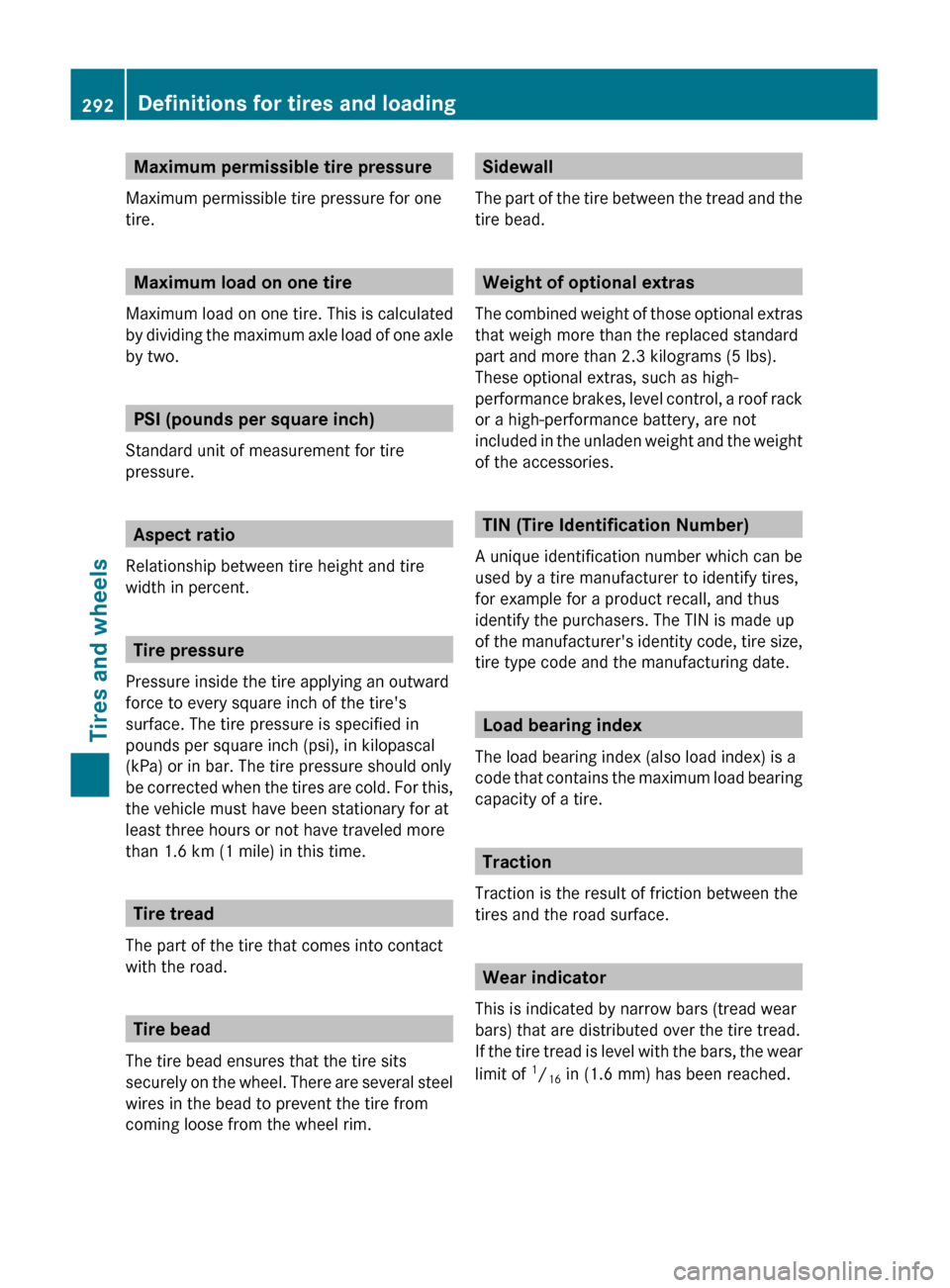
Maximum permissible tire pressure
Maximum permissible tire pressure for one
tire.
Maximum load on one tire
Maximum load on one tire. This is calculated
by dividing the maximum axle load of one axle
by two.
PSI (pounds per square inch)
Standard unit of measurement for tire
pressure.
Aspect ratio
Relationship between tire height and tire
width in percent.
Tire pressure
Pressure inside the tire applying an outward
force to every square inch of the tire's
surface. The tire pressure is specified in
pounds per square inch (psi), in kilopascal
(kPa) or in bar. The tire pressure should only
be corrected when the tires are cold. For this,
the vehicle must have been stationary for at
least three hours or not have traveled more
than 1.6 km (1 mile) in this time.
Tire tread
The part of the tire that comes into contact
with the road.
Tire bead
The tire bead ensures that the tire sits
securely on the wheel. There are several steel
wires in the bead to prevent the tire from
coming loose from the wheel rim.
Sidewall
The part of the tire between the tread and the
tire bead.
Weight of optional extras
The combined weight of those optional extras
that weigh more than the replaced standard
part and more than 2.3 kilograms (5 lbs).
These optional extras, such as high-
performance brakes, level control, a roof rack
or a high-performance battery, are not
included in the unladen weight and the weight
of the accessories.
TIN (Tire Identification Number)
A unique identification number which can be
used by a tire manufacturer to identify tires,
for example for a product recall, and thus
identify the purchasers. The TIN is made up
of the manufacturer's identity code, tire size,
tire type code and the manufacturing date.
Load bearing index
The load bearing index (also load index) is a
code that contains the maximum load bearing
capacity of a tire.
Traction
Traction is the result of friction between the
tires and the road surface.
Wear indicator
This is indicated by narrow bars (tread wear
bars) that are distributed over the tire tread.
If the tire tread is level with the bars, the wear
limit of 1
/ 16 in (1.6 mm) has been reached.
292Definitions for tires and loadingTires and wheels
BA 204 USA, CA Edition A 2011; 1; 5, en-UShereepeVersion: 3.0.3.62010-05-20T09:17:30+02:00 - Seite 292
Page 295 of 320
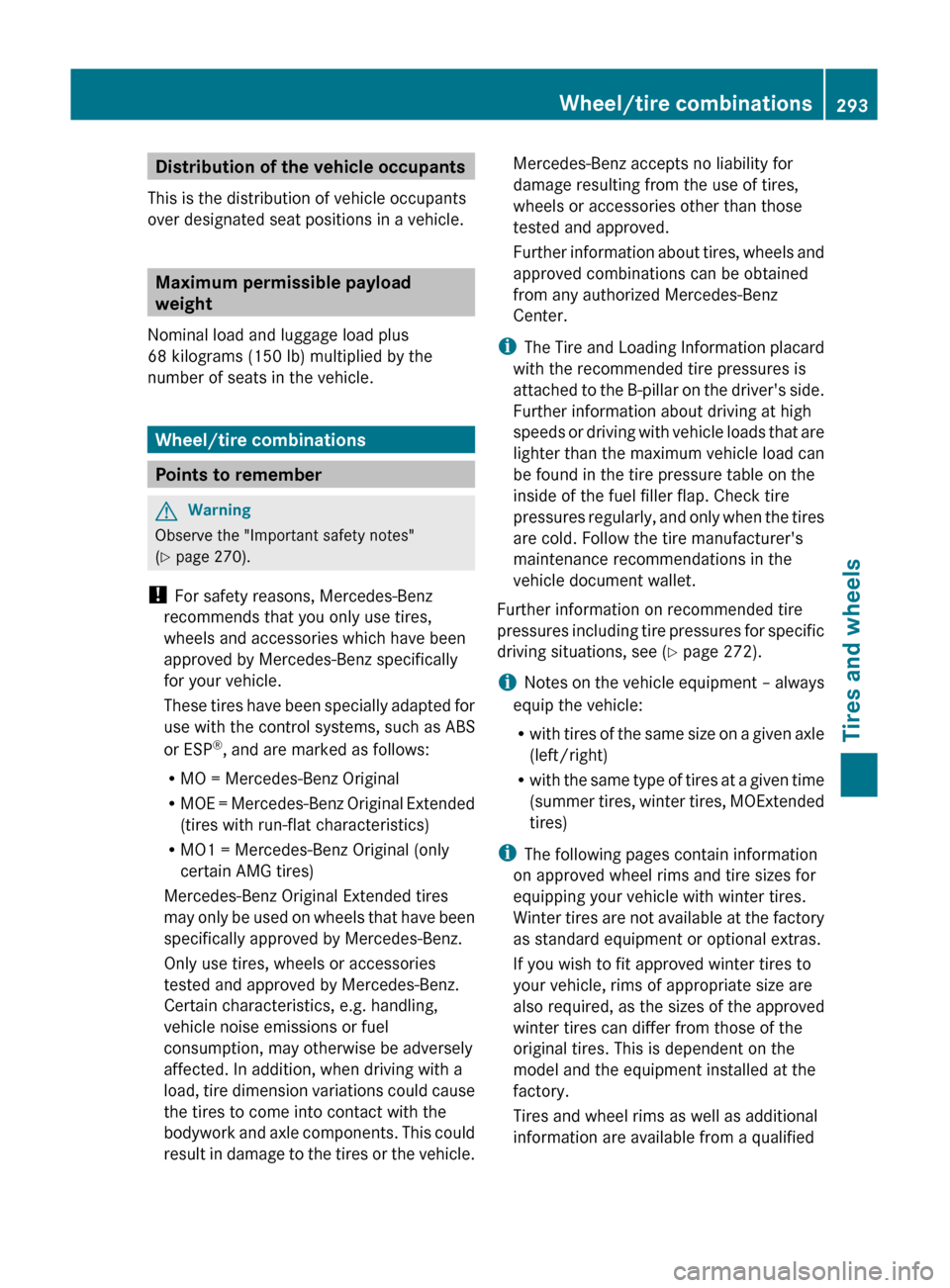
Distribution of the vehicle occupants
This is the distribution of vehicle occupants
over designated seat positions in a vehicle.
Maximum permissible payload
weight
Nominal load and luggage load plus
68 kilograms (150 lb) multiplied by the
number of seats in the vehicle.
Wheel/tire combinations
Points to remember
GWarning
Observe the "Important safety notes"
( Y page 270).
! For safety reasons, Mercedes-Benz
recommends that you only use tires,
wheels and accessories which have been
approved by Mercedes-Benz specifically
for your vehicle.
These tires have been specially adapted for
use with the control systems, such as ABS
or ESP ®
, and are marked as follows:
R MO = Mercedes-Benz Original
R MOE = Mercedes-Benz Original Extended
(tires with run-flat characteristics)
R MO1 = Mercedes-Benz Original (only
certain AMG tires)
Mercedes-Benz Original Extended tires
may only be used on wheels that have been
specifically approved by Mercedes-Benz.
Only use tires, wheels or accessories
tested and approved by Mercedes-Benz.
Certain characteristics, e.g. handling,
vehicle noise emissions or fuel
consumption, may otherwise be adversely
affected. In addition, when driving with a
load, tire dimension variations could cause
the tires to come into contact with the
bodywork and axle components. This could
result in damage to the tires or the vehicle.
Mercedes-Benz accepts no liability for
damage resulting from the use of tires,
wheels or accessories other than those
tested and approved.
Further information about tires, wheels and
approved combinations can be obtained
from any authorized Mercedes-Benz
Center.
i The Tire and Loading Information placard
with the recommended tire pressures is
attached to the B-pillar on the driver's side.
Further information about driving at high
speeds or driving with vehicle loads that are
lighter than the maximum vehicle load can
be found in the tire pressure table on the
inside of the fuel filler flap. Check tire
pressures regularly, and only when the tires
are cold. Follow the tire manufacturer's
maintenance recommendations in the
vehicle document wallet.
Further information on recommended tire
pressures including tire pressures for specific
driving situations, see ( Y page 272).
i Notes on the vehicle equipment – always
equip the vehicle:
R with tires of the same size on a given axle
(left/right)
R with the same type of tires at a given time
(summer tires, winter tires, MOExtended
tires)
i The following pages contain information
on approved wheel rims and tire sizes for
equipping your vehicle with winter tires.
Winter tires are not available at the factory
as standard equipment or optional extras.
If you wish to fit approved winter tires to
your vehicle, rims of appropriate size are
also required, as the sizes of the approved
winter tires can differ from those of the
original tires. This is dependent on the
model and the equipment installed at the
factory.
Tires and wheel rims as well as additional
information are available from a qualifiedWheel/tire combinations293Tires and wheelsBA 204 USA, CA Edition A 2011; 1; 5, en-UShereepeVersion: 3.0.3.62010-05-20T09:17:30+02:00 - Seite 293Z
Page 296 of 320
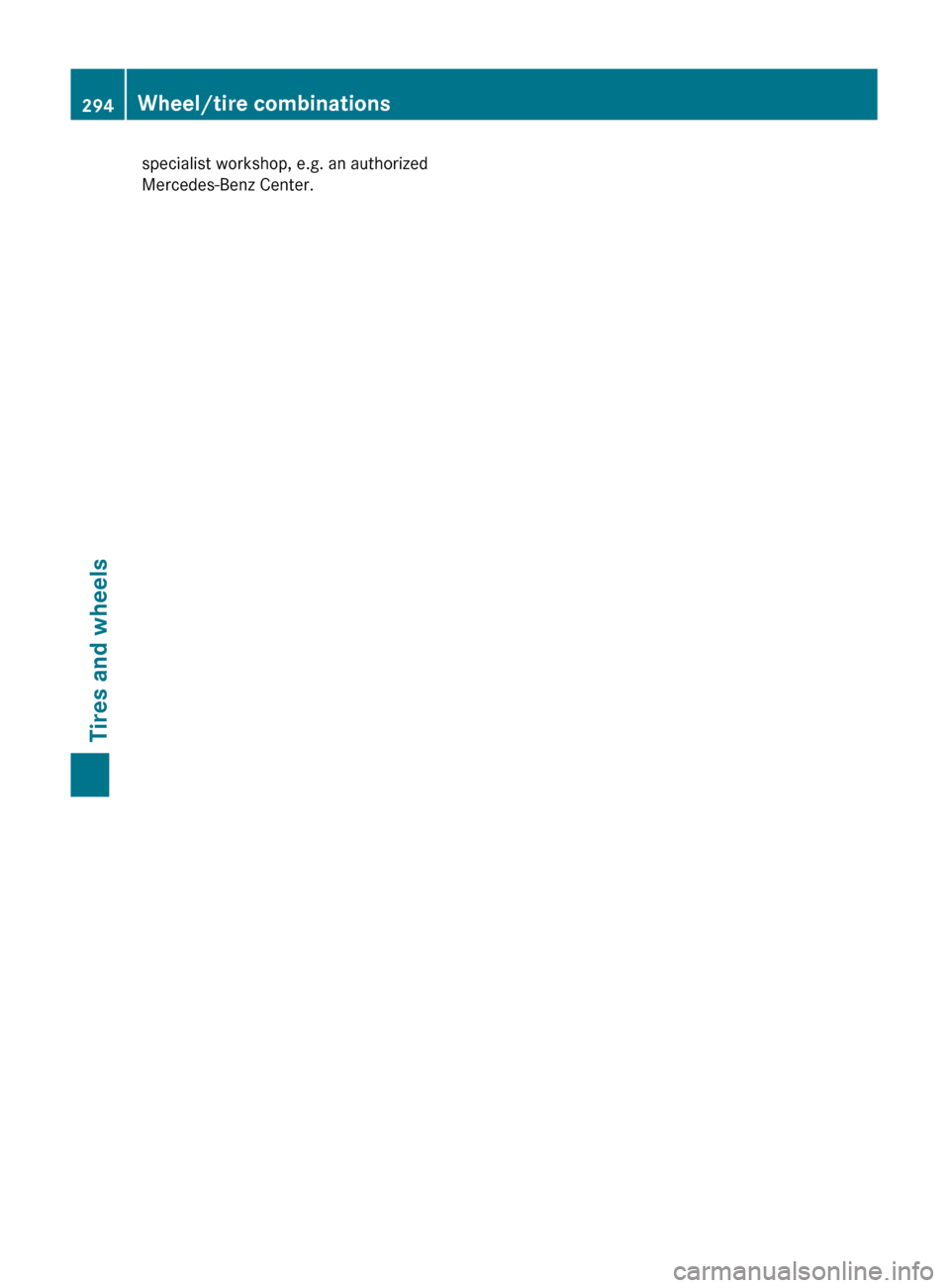
specialist workshop, e.g. an authorized
Mercedes-Benz Center.294Wheel/tire combinationsTires and wheels
BA 204 USA, CA Edition A 2011; 1; 5, en-UShereepeVersion: 3.0.3.62010-05-20T09:17:30+02:00 - Seite 294
Page 297 of 320
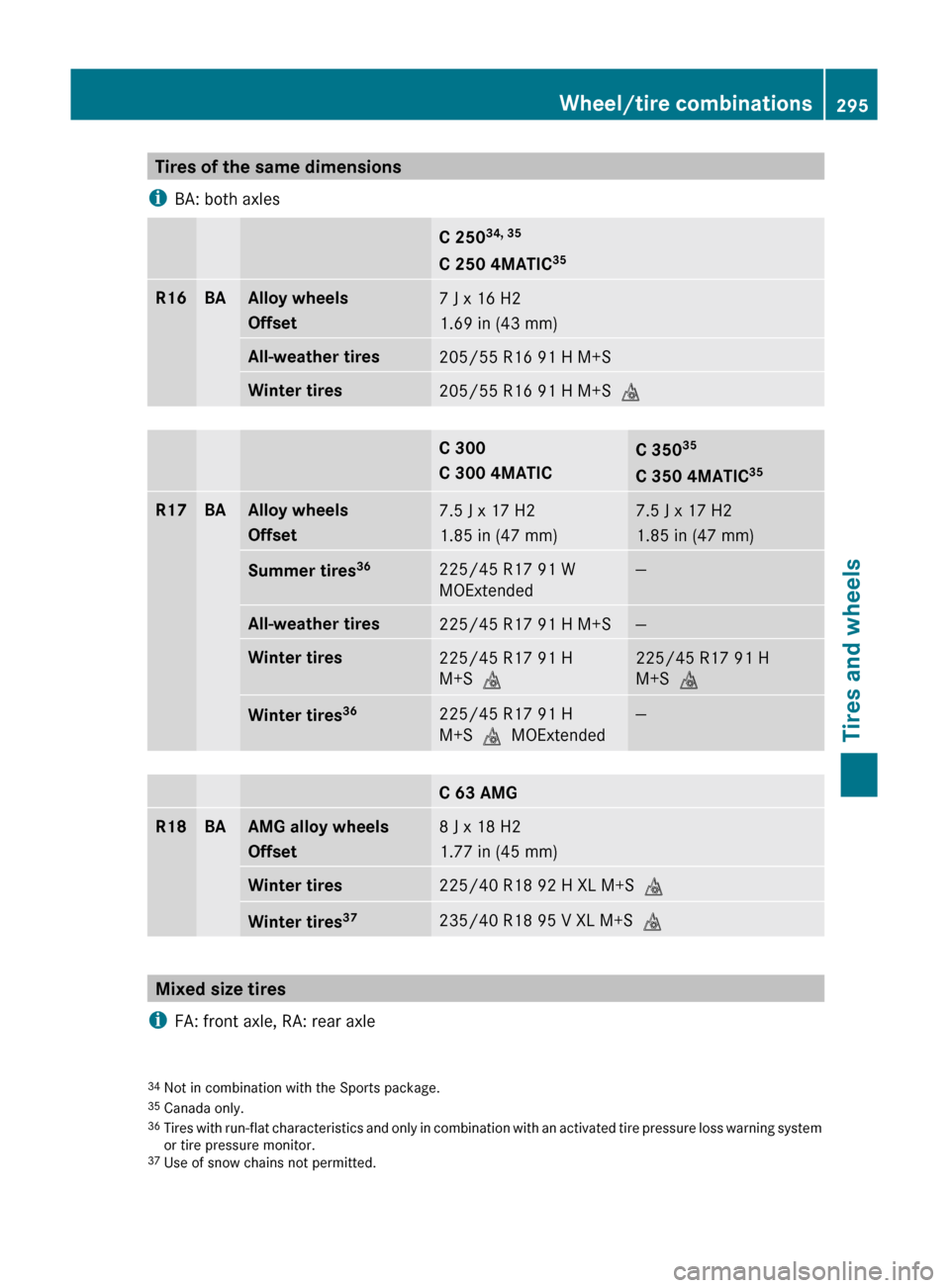
Tires of the same dimensions
i BA: both axlesC 250 34, 35
C 250 4MATIC 35R16BAAlloy wheels
Offset7 J x 16 H2
1.69 in (43 mm)All-weather tires205/55 R16 91 H M+SWinter tires205/55 R16 91 H M+S iC 300
C 300 4MATICC 350 35
C 350 4MATIC 35R17BAAlloy wheels
Offset7.5 J x 17 H2
1.85 in (47 mm)7.5 J x 17 H2
1.85 in (47 mm)Summer tires 36225/45 R17 91 W
MOExtended—All-weather tires225/45 R17 91 H M+S—Winter tires225/45 R17 91 H
M+S i225/45 R17 91 H
M+S iWinter tires 36225/45 R17 91 H
M+S i MOExtended—C 63 AMGR18BAAMG alloy wheels
Offset8 J x 18 H2
1.77 in (45 mm)Winter tires225/40 R18 92 H XL M+S iWinter tires37235/40 R18 95 V XL M+S
i
Mixed size tires
i FA: front axle, RA: rear axle
34
Not in combination with the Sports package.
35 Canada only.
36 Tires with run-flat characteristics and only in combination with an activated tire pressure loss warning system
or tire pressure monitor.
37 Use of snow chains not permitted.Wheel/tire combinations295Tires and wheelsBA 204 USA, CA Edition A 2011; 1; 5, en-UShereepeVersion: 3.0.3.62010-05-20T09:17:30+02:00 - Seite 295Z
Page 298 of 320
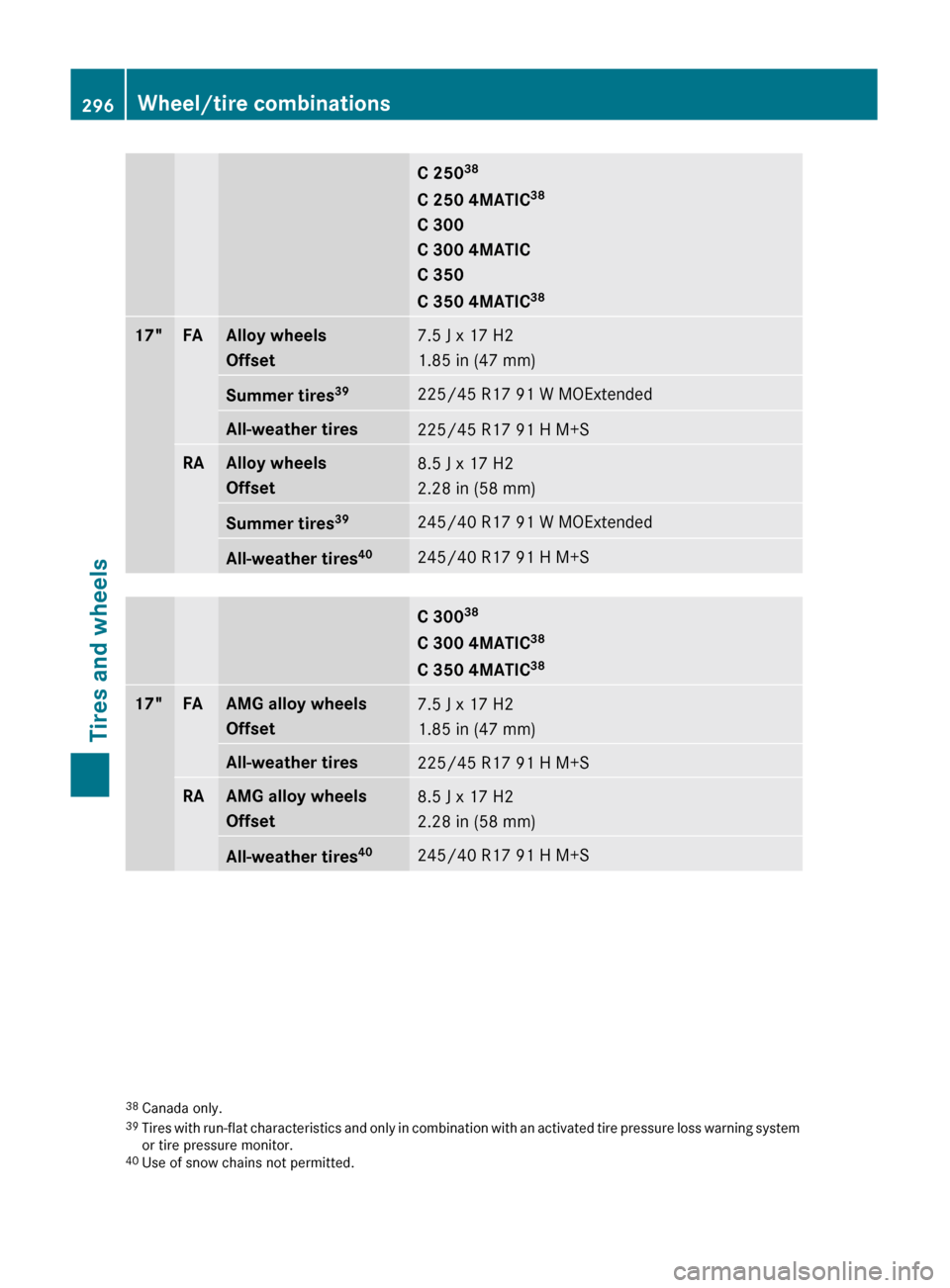
C 25038
C 250 4MATIC 38
C 300
C 300 4MATIC
C 350
C 350 4MATIC 3817"FAAlloy wheels
Offset7.5 J x 17 H2
1.85 in (47 mm)Summer tires 39225/45 R17 91 W MOExtendedAll-weather tires225/45 R17 91 H M+SRAAlloy wheels
Offset8.5 J x 17 H2
2.28 in (58 mm)Summer tires 39245/40 R17 91 W MOExtendedAll-weather tires 40245/40 R17 91 H M+SC 30038
C 300 4MATIC 38
C 350 4MATIC 3817"FAAMG alloy wheels
Offset7.5 J x 17 H2
1.85 in (47 mm)All-weather tires225/45 R17 91 H M+SRAAMG alloy wheels
Offset8.5 J x 17 H2
2.28 in (58 mm)All-weather tires 40245/40 R17 91 H M+S38
Canada only.
39 Tires with run-flat characteristics and only in combination with an activated tire pressure loss warning system
or tire pressure monitor.
40 Use of snow chains not permitted.296Wheel/tire combinationsTires and wheels
BA 204 USA, CA Edition A 2011; 1; 5, en-UShereepeVersion: 3.0.3.62010-05-20T09:17:30+02:00 - Seite 296
Page 299 of 320
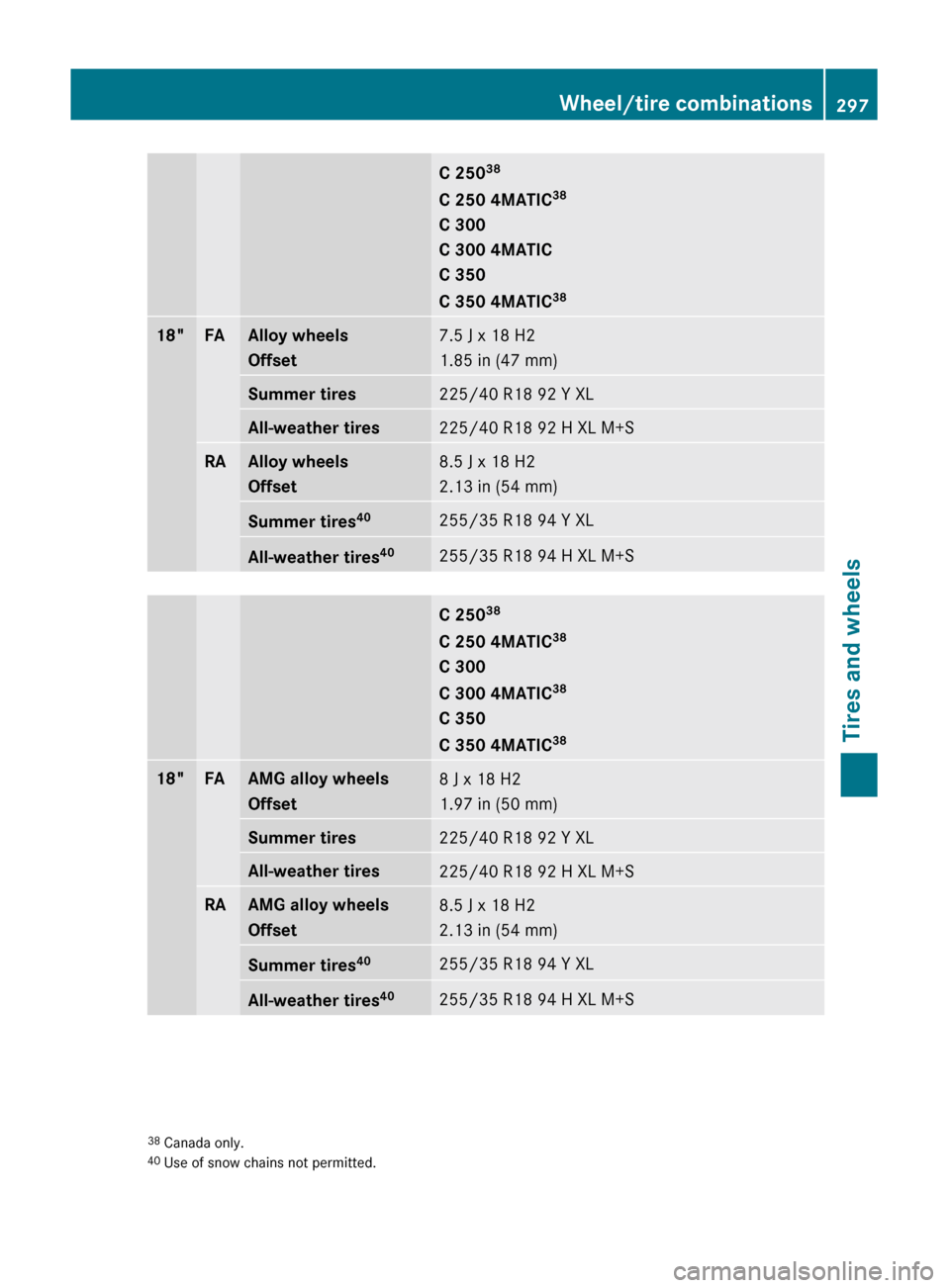
C 25038
C 250 4MATIC 38
C 300
C 300 4MATIC
C 350
C 350 4MATIC 3818"FAAlloy wheels
Offset7.5 J x 18 H2
1.85 in (47 mm)Summer tires225/40 R18 92 Y XLAll-weather tires225/40 R18 92 H XL M+SRAAlloy wheels
Offset8.5 J x 18 H2
2.13 in (54 mm)Summer tires 40255/35 R18 94 Y XLAll-weather tires 40255/35 R18 94 H XL M+SC 25038
C 250 4MATIC 38
C 300
C 300 4MATIC 38
C 350
C 350 4MATIC 3818"FAAMG alloy wheels
Offset8 J x 18 H2
1.97 in (50 mm)Summer tires225/40 R18 92 Y XLAll-weather tires225/40 R18 92 H XL M+SRAAMG alloy wheels
Offset8.5 J x 18 H2
2.13 in (54 mm)Summer tires 40255/35 R18 94 Y XLAll-weather tires 40255/35 R18 94 H XL M+S38
Canada only.
40 Use of snow chains not permitted.Wheel/tire combinations297Tires and wheelsBA 204 USA, CA Edition A 2011; 1; 5, en-UShereepeVersion: 3.0.3.62010-05-20T09:17:30+02:00 - Seite 297Z
Page 300 of 320
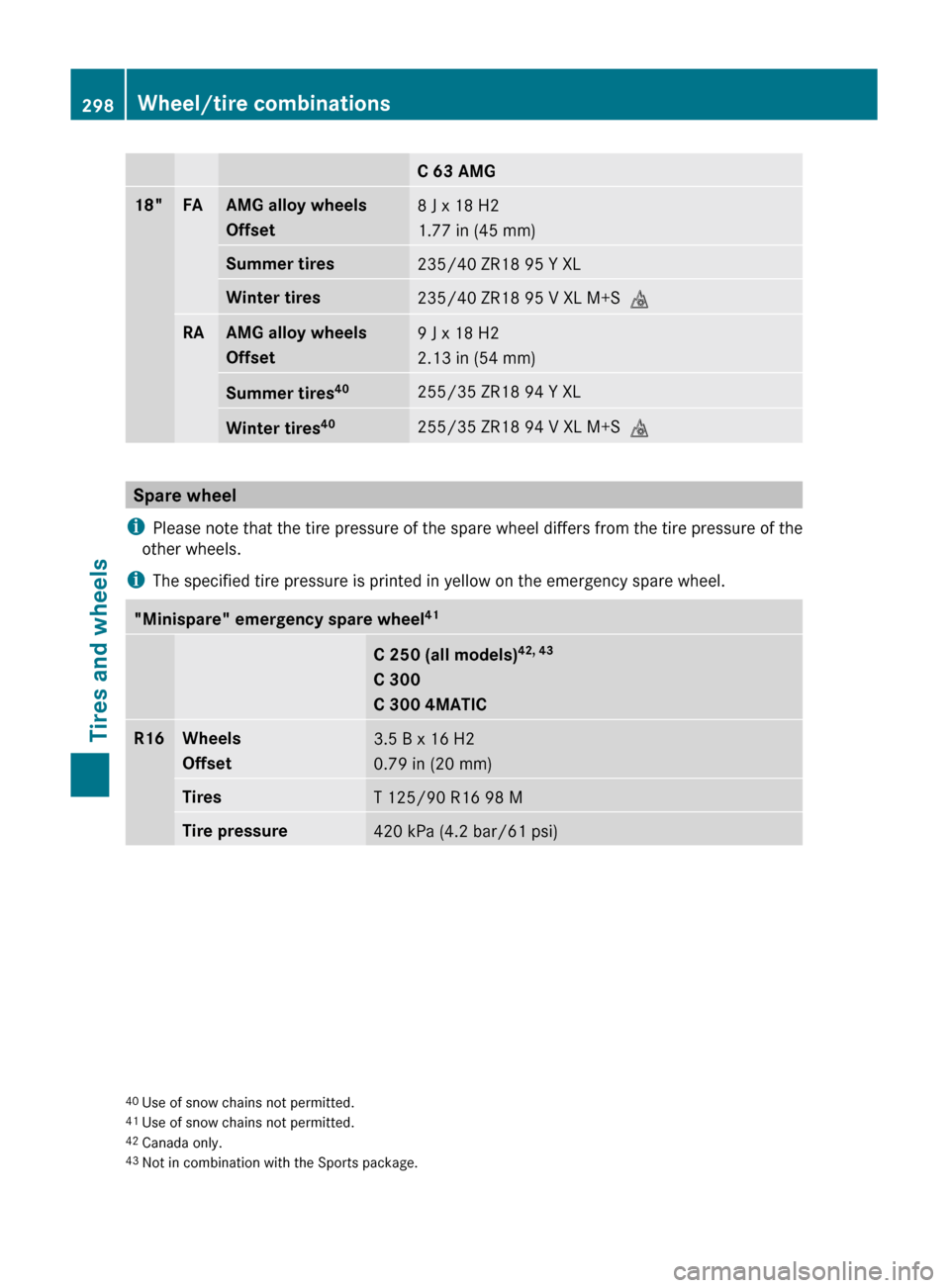
C 63 AMG18"FAAMG alloy wheels
Offset8 J x 18 H2
1.77 in (45 mm)Summer tires235/40 ZR18 95 Y XLWinter tires235/40 ZR18 95 V XL M+S iRAAMG alloy wheels
Offset9 J x 18 H2
2.13 in (54 mm)Summer tires 40255/35 ZR18 94 Y XLWinter tires40255/35 ZR18 94 V XL M+S
i
Spare wheel
i Please note that the tire pressure of the spare wheel differs from the tire pressure of the
other wheels.
i The specified tire pressure is printed in yellow on the emergency spare wheel.
"Minispare" emergency spare wheel 41C 250 (all models)42, 43
C 300
C 300 4MATICR16Wheels
Offset3.5 B x 16 H2
0.79 in (20 mm)TiresT 125/90 R16 98 MTire pressure420 kPa (4.2 bar/61 psi)40 Use of snow chains not permitted.
41 Use of snow chains not permitted.
42 Canada only.
43 Not in combination with the Sports package.298Wheel/tire combinationsTires and wheels
BA 204 USA, CA Edition A 2011; 1; 5, en-UShereepeVersion: 3.0.3.62010-05-20T09:17:30+02:00 - Seite 298